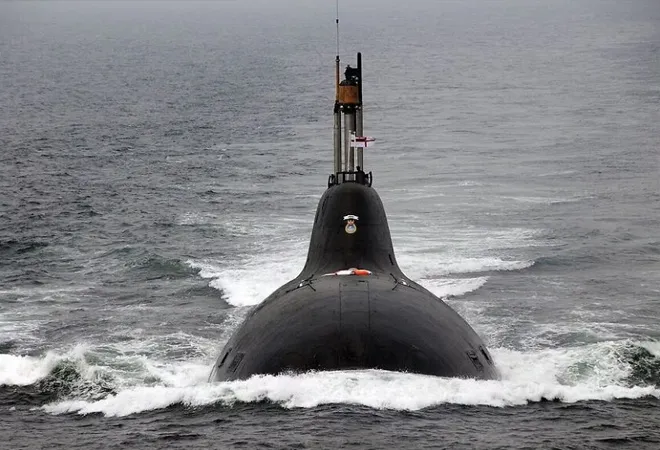-
CENTRES
Progammes & Centres
Location
Pakistan and China’s nuclear capabilities along with the added challenges and risks of a complex and uncertain environment in the Indo-Pacific are vindication of India’s foresight with the Pokhran II tests in 1998

This piece is part of the series, 25 Years Since Pokhran II: Reviewing India’s Nuclear Odyssey
Twenty-five years since its nuclear tests at Pokhran, India today occupies a key and significant position in the global and regional environment, with rapidly increasing relevance and importance in its role in promoting stability, security, and development in the Indo-Pacific region. It has also emerged as a responsible nuclear power, with a balanced nuclear doctrine and strong safeguards firmly in place. It has refrained from any irresponsible nuclear signalling or brinkmanship during localised confrontations. At the same time, the nuclear deterrence capability has been gradually strengthened, with development and trials of weapons, delivery platforms, command and control systems, as well as for transportation and storage of sensitive materials. The land-based and airborne delivery capabilities together have initially provided for retaliation in case of a nuclear attack, as outlined in India’s nuclear doctrine that was released in January 2003.
India’s SSBN Programme
The critical importance of submarine-launched nuclear weapon capability—commonly referred to as the third leg of the nuclear triad—was recognized early, particularly since its inherent flexibility, survivability, and secrecy aligned well with India’s no-first use (NFU) and credible minimum deterrence policy. A new model of partnership between the Indian Navy, Defence Research and Development Organisation (DRDO), and the private sector to indigenously build nuclear-powered, nuclear ballistic missile carrying submarines (SSBN) was evolved and executed, with Russian assistance in some areas. Valuable experience was gained in parallel by the Indian Navy in operating submarines with nuclear propulsion (SSN) through the lease of Chakra-I from the erstwhile Soviet Union from 1988 to 1991, and the Chakra-II from Russia between 2012 and 2021. A contract for the lease of another Russian SSN from 2025 onwards was also signed in 2019.
The nuclear deterrence capability has been gradually strengthened, with development and trials of weapons, delivery platforms, command and control systems, as well as for transportation and storage of sensitive materials.
After surmounting numerous challenges, the first indigenous SSBN was launched in 2009 and commissioned as INS Arihant (codenamed S2) in 2016. The submarine undertook its first deterrent patrol in 2018. The crew was felicitated by the Indian Prime Minister upon operationalisation of the country’s nuclear triad. The Prime Minister also highlighted India’s robust command and control structure and effective safety assurance architecture with strict protocols under the Nuclear Command Authority. In 2022, the submarine undertook the first successful launch of its ballistic missile. Concerns related to the limited range of the K15 ballistic missile carried by the submarine have been addressed gradually, with successful tests of higher range versions. Aspects related to complex maintenance, training, and operational procedures were also put in place. Numerous innovative measures were undertaken to improve infrastructure related to building capacity. The next SSBN (codenamed S3 and to be commissioned as INS Arighat) was launched in November 2017 and has been undergoing trials. It is expected to be commissioned soon.
Need was also felt to enhance numerous design features, many of which are being incorporated in the next two submarines, S4 and S4 Star. Clearance for setting up infrastructure for a bigger and more capable SSBN, codenamed S5, was accorded as part of the next generation of SSBNs. The indigenous content in the submarines has also been significantly increased in all three areas of float, move, and fight. However, the time period between launch and commissioning of SSBNs has been long and needs to be brought down.
Deterrence against China
Both India and China have a no-first use policy on nuclear weapons. Despite internal debate, both have chosen to persist with the same. The Chinese nuclear weapons programme, including submarine-based capabilities, has moved forward rapidly in recent years, and is poised to sustain its momentum in the coming decade. Its arsenal is likely to reach around 700 nuclear warheads by 2027, from nearly 400 warheads now. With a balanced approach, India does not seek parity in numbers with its nuclear neighbours but plans to maintain adequacy in line with its promulgated policies. Progress on credible minimum deterrence continues to be an important pillar, given the aggressive and coercive actions of China along the Line of Actual Control between the two countries. In addition, the broader Chinese approach in the region has been a cause of concern. In the aftermath of clashes and military build-up in eastern Ladakh (and subsequently in other theatres), the subject of nuclear deterrence again took centre stage. Here, it is important to underline that submarines with nuclear weapons do not come under the category of low-yield tactical nuclear weapons, and provide a credible, second-strike capability to deter any first use of nuclear weapons. They bring a unique capability to the country’s defence, contributing significantly towards strategic stability.
The Chinese nuclear weapons programme, including submarine-based capabilities, has moved forward rapidly in recent years, and is poised to sustain its momentum in the coming decade.
One of the takeaways from the ongoing border standoff and bilateral discussions with China has been that the threat from China is likely to persist. The need to enhance organic capabilities in compressed timeframes, and to be ready for any escalation of a localised military confrontation has also been recognised. National capabilities are critical since India does not plan to be part of any hard power military alliance in the Indo-Pacific. New weapons and technologies, including hypersonic delivery platforms and cyber tools, have the potential to impact traditional deterrence mechanisms that threaten retaliation. A diversified and broader China facing nuclear deterrence capability has, therefore, become more relevant for India in the prevailing security environment, with SSBNs being a crucial and important pillar.
Key imperatives
Unlike land and air vectors, SSBN deployments need to factor the transit (from and to) periods to patrol areas, and the submarine maintenance cycles. A minimum inventory of four to six SSBNs therefore becomes essential for sustaining a credible second-strike capability over prolonged timeframes. This inventory can enable faster change in the readiness status depending on the situation. These submarines need to have nuclear reactors with adequate hours on station, weapons with long ranges and adequate yield, and onboard equipment with very high quality, reliability and performance standards.
A diversified and broader China facing nuclear deterrence capability has, therefore, become more relevant for India in the prevailing security environment, with SSBNs being a crucial and important pillar.
Ongoing efforts should lead to accelerated submarine building, trials, and operationalisation of India’s first full SSBN squadron. These should eventually result in regular deterrent patrols in different areas. The progress made in enhancing the percentage of indigenous content would also need to be complemented with high quality standards and spares support. Diversification of sources of supply and new bilateral arrangements may be considered for critical technologies where foreign assistance is either inescapable or desirable.
In May 1998, India had communicated that the reason for the nuclear tests at Pokhran was the nuclear capability and tests of China, and China-Pakistan military cooperation. This rationale has been vindicated and is far stronger now, with the added challenges and risks of a complex and uncertain environment in the Indo-Pacific. A strong and credible third leg of India’s nuclear triad is an imperative which is likely to be accorded the priority it deserves.
Girish Luthra is a Distinguished Fellow at the Observer Research Foundation
The views expressed above belong to the author(s). ORF research and analyses now available on Telegram! Click here to access our curated content — blogs, longforms and interviews.

Vice Admiral Girish Luthra is Distinguished Fellow at Observer Research Foundation, Mumbai. He is Former Commander-in-Chief of Western Naval Command, and Southern Naval Command, Indian ...
Read More +